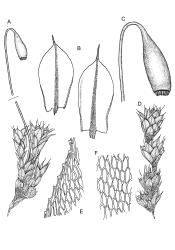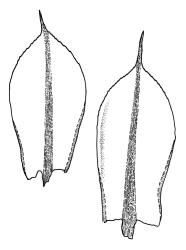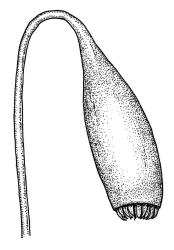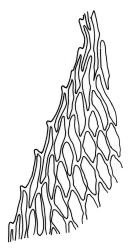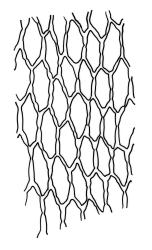- ≡ Bryum campylothecium Taylor, London J. Bot. 5: 52 (1846)
Plants gold or brown-green, strongly comose (often serially). Stems red-brown, c. 15–25 mm, branching by one or several innovations arising from within or below the perichaetium, in cross-section as per genus. Leaves larger and crowded at stem apex, erect-spreading when moist, ± erect and little altered or twisted around the stem when dry, oblong-ovate or ± obovate, widest at or slightly above mid leaf, tapered to an acute and strongly awned apex, c. 2–3.2 mm, with lamina c. 0.8 the total leaf length, concave, golden throughout (lacking secondary pigmentation at base), sharply denticulate near apex, weakly bordered and narrowly recurved (seen clearly only by cross-section) at margins, denticulate above; upper laminal cells hexagonal or oblong-hexagonal, firm-walled, porose or not, 30–45 × 12–15 µm and c. 3:1, somewhat smaller near apex, more oblong and thinner-walled near leaf base, not obliquely oriented; marginal cells very weakly differentiated in c. 2 rows of elongate cells at mid leaf, not extending to apex and often obscured at mid leaf by recurved margins; basal cells not differentiated or pigmented. Costa rather stout, yellow-brown throughout, long-excurrent and forming an elongate, denticulate awn commonly 275–600 µm long. Brood bodies absent.
Dioicous. Perichaetia terminal, with leaves more oblong-lanceolate than vegetative leaves. Perigonia terminal, superficially indistinguishable from perichaetia and rarely seen. Setae single, 17–20 mm, strongly curved (but not hooked) just below capsule; capsules pendent, elongate oblong-cylindric, weakly curved, narrowed to (but not constricted below) the mouth, (2.8–)3.0–3.5 mm, with a narrow and well-defined neck c. ⅓ the total capsule length; operculum mammillate, not apiculate, red-brown. Exostome teeth yellow-brown; endostome with narrowly perforate segments and paired, nodose, and elongate cilia. Spores 15–21 µm, ± insulate.
Ochi 1970, fig. 32 (as Bryum campylothecium); Catcheside 1980, fig. 153 (as B. campylothecium); Spence & Ramsay 2006, fig. 46, t–aa.
Not all sterile material can be confidently distinguished from R. capillare, particularly when that species grows in coastal situations. Generally, R. campylothecium can be distinguished from R. capillare by the more strongly comose set of its leaves, golden-brown colouration, stouter awns, and more thick-walled, ± porose laminal cells. When fruiting, the two species are distinguishable by several features, including the nature of their endostomal cilia and spore size.
Confusion also occurs with R. subtomentosum but the more erect stance of the leaves with their straight awns and lack of a conspicuous border, larger spores, non-appendiculate endostomal cilia, and absence of tubers are among numerous features that distinguish R. campylothecium from that variable species.
Rosulabryum campylothecium could be confused with the similarly-coloured and serially comose Bryum crassum. Rosulabryum campylothecium has strongly awned comal leaves in which the awn is up to c. 0.2 the total leaf length and non-obliquely oriented juxtacostal cells, while B. crassum has short excurrent costae forming a small cusp (rather than an awn) and strongly obliquely oriented juxtacostal cells in the upper leaf. Bryum crassum also differs by having strongly recurved leaf margins and by sporophyte characters.
NI: N Auckland including offshore islands (TK, PK, HC, LB, GB, RT), S Auckland, Gisborne, Hawke's Bay, Wellington; SI: Marlborough, Canterbury (Port Hills, Birdlings Flat), Westland (near Greymouth, Jackson Bay), Otago; Ch.
Australasian. Tasmania*, mainland Australia*. Reported from Lord Howe I. by Scott & Stone (1976, p. 284).
Usually on thin soil (sometimes humic) over rock, including basalt, breccia, and limestone; often on sand in dune hollows or on stable dunes, and occasionally on rock faces; usually in exposed, highly insolated sites but occasionally partially shaded in Kunzea and/or Leptospermum scrub. Sometimes occurring among introduced grasses. This is a characteristic species of coastal situations throughout most of the main islands, but it can also be well-developed in suitable sites well away from the sea (as at Ātiamuri, S Auckland L.D.). From sea level to c. 350 m on North I. and to at least 400 m on South I. Commonly occurring with other Rosulabrya, Leptodontium interruptum, Pseudocrossidium crinitum, Syntrichia princeps, and Triquetrella papillata.
The shape of the capsule is distinctive and, given its gradual narrowing to the mouth and slight curve, was aptly described as banana-shaped by Scott & Stone (1976).




